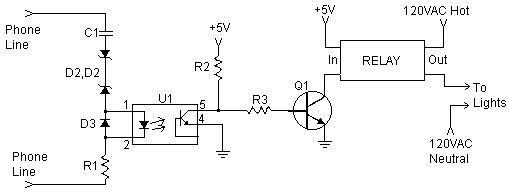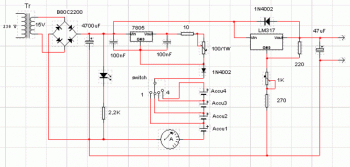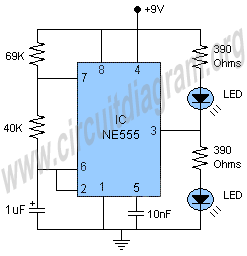
Ringing Phone Light Flasher circuit

The inquiry pertains to the connection of lights that flash when a phone rings. This feature is particularly beneficial in noisy environments, such as workshops, where hearing the phone may be difficult. A device designed for this purpose is presented, with the ring detection component of the circuit sourced from...
To implement a circuit that enables lights to flash in response to a ringing phone, a comprehensive understanding of both the ring detection mechanism and the control of the lighting system is essential. The circuit can be divided into two primary sections: the ring detection circuit and the output control circuit for the lights.
The ring detection circuit typically utilizes a transformer to step down the voltage from the phone line. The ringing signal, which is an alternating current (AC) signal, is then rectified using a diode to convert it into a direct current (DC) signal. This DC signal can be further processed using a transistor or an operational amplifier to create a triggering signal that indicates when the phone is ringing.
Once the ring detection circuit generates a signal, this signal is fed into the output control circuit. The output circuit can consist of a relay or a solid-state switch that controls the power to the lights. When the triggering signal is received, the relay closes, allowing current to flow to the connected lights, causing them to flash. The lights can be standard incandescent bulbs, LED strips, or any other type of visual alerting system suitable for the environment.
To ensure proper functionality, it is crucial to incorporate safety features, such as fuses or circuit breakers, to protect against overloads. Additionally, the circuit can be designed to include adjustable sensitivity settings, allowing users to customize the response based on their specific environment and needs.
Overall, this circuit serves as an effective solution for alerting individuals in loud environments, providing a visual indication of incoming phone calls. With careful design and implementation, the flashing lights can significantly enhance communication in settings where auditory alerts are insufficient.You are asking how to connect up some lights so that when the phone rings, they flash. This is very useful in a situation were there is lots of noise and it is impossable to hear the phone, such as a workshop. Here is such a device. The ring detect part of this circuit came from.. 🔗 External reference
To implement a circuit that enables lights to flash in response to a ringing phone, a comprehensive understanding of both the ring detection mechanism and the control of the lighting system is essential. The circuit can be divided into two primary sections: the ring detection circuit and the output control circuit for the lights.
The ring detection circuit typically utilizes a transformer to step down the voltage from the phone line. The ringing signal, which is an alternating current (AC) signal, is then rectified using a diode to convert it into a direct current (DC) signal. This DC signal can be further processed using a transistor or an operational amplifier to create a triggering signal that indicates when the phone is ringing.
Once the ring detection circuit generates a signal, this signal is fed into the output control circuit. The output circuit can consist of a relay or a solid-state switch that controls the power to the lights. When the triggering signal is received, the relay closes, allowing current to flow to the connected lights, causing them to flash. The lights can be standard incandescent bulbs, LED strips, or any other type of visual alerting system suitable for the environment.
To ensure proper functionality, it is crucial to incorporate safety features, such as fuses or circuit breakers, to protect against overloads. Additionally, the circuit can be designed to include adjustable sensitivity settings, allowing users to customize the response based on their specific environment and needs.
Overall, this circuit serves as an effective solution for alerting individuals in loud environments, providing a visual indication of incoming phone calls. With careful design and implementation, the flashing lights can significantly enhance communication in settings where auditory alerts are insufficient.You are asking how to connect up some lights so that when the phone rings, they flash. This is very useful in a situation were there is lots of noise and it is impossable to hear the phone, such as a workshop. Here is such a device. The ring detect part of this circuit came from.. 🔗 External reference





